This is why you should have the right landscape lights. You don’t want to choose any outdoor lighting that will overpower the beauty of your external space. It should just be enough to highlight the beautiful features outdoors.
When choosing the right outdoor lighting fixtures, you have to keep in mind a couple of things. It has to be functional, energy-efficient, sustainable, and aesthetically appealing as well.
This article will help you find the perfect light fixtures that will bring out the incredible beauty of your outdoor landscape.
What is Outdoor Lighting?
Outdoor lights, as the name suggests, are for external spaces. Its job is to illuminate outdoor areas at night. While people position these fixtures for landscape lighting purposes, it can do more than that. These can also increase security in the area. These outdoor light fixtures can light the area, so it’s safe for people to move around at night. Apart from that, having enough brightness in the area will deter intruders.
When choosing among the different types of outdoor lighting, it’s essential to consider the qualities that will make it functional in outdoor spaces. For instance, since these lighting fixtures are outdoors, they must be weather resistant. That means it should withstand exposure to the Sun and rain showers.
This outdoor lighting guide will help you understand the different qualities that will make an outdoor lighting fixture perfect. That way, you’ll know the best way to apply and use them to complement your external area.

What are the Advantages of using Outdoor Lighting?
From security to visual appeal, there are many reasons why it’s beneficial to have the right outdoor light fixture.
● Improves aesthetics. The outdoor lights will enhance the beauty of your outdoor living space. If you choose the correct fixture and position it well, it could bring out the natural beauty of your external area. You can use accent lighting to highlight architectural structures or landscape features like trees, plants, flower beds, etc. Water features in your garden can benefit from underwater lights. The correct outdoor lights can also help you set the perfect mood and energy.
● Amplifies security and safety. There are many ways this can happen. Having enough garden lights will deter intruders from trespassing in your space, even at night. If you install motion detector lights, it will also boost security in the area. The illumination provided by security lights, like floodlights, will also make the site visible to people moving around. It can minimize the occurrence of accidents.
● Increases property value. Installing the right outdoor lights for commercial or residential use can increase the property’s value. It can illuminate the most beautiful features of the property – making it more appealing to anyone looking at it.
● Allows outdoor living even at night. Finally, suitable outdoor lighting will enable you to enjoy it at night. You’ll feel safer, and you can also choose the proper ambient lighting to provide the mood you want to have. If you wish to party or relax in your outdoor space, the right lights will help you experience that.
Various Types of Outdoor Lighting
There are different types of outdoor lighting that you can choose from. Each of these lights addresses additional lighting requirements. Knowing how each lighting option works will make it easier for you to choose the correct fixture. Specifically, the one that will provide the right lighting mood for your outdoor areas.
Let’s go through these lights one by one.
Floodlights
Floodlights are perfect for directional lighting. As the name suggests, these outdoor lights can flood an area with brightness. Its beam of light can go as wide as 120 degrees. This makes it ideal for security purposes. That means you can pair floodlights with security equipment outdoors. You can point it where people are most likely to pass through. Using motion sensor lights will also add to the security feature. It will startle trespassers and make them think twice about their malicious intent. Just make sure that you won’t make the lights too bright. That way, it doesn’t startle the neighbors or cause any light pollution.
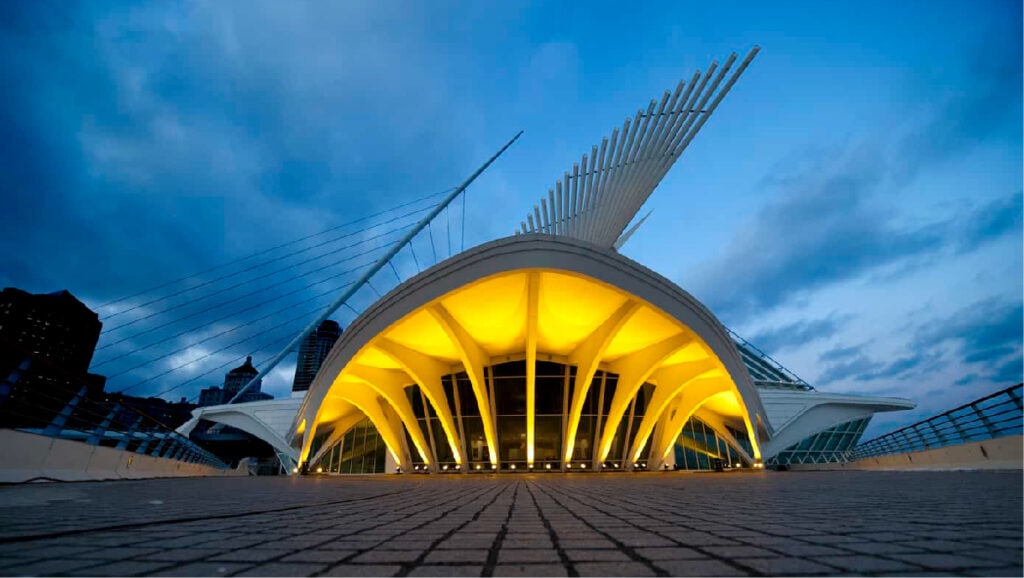
Spotlights
Spotlights are just like floodlights. But it does have a narrower beam of only 45 degrees. While floodlights are great for lighting up general areas, spotlights allow you to set the mood. It can be used as ambient lighting or to highlight features in your outdoor space. You can point it towards a water feature in your garden. Or you can use it to highlight a structural element in your landscape. You can even use it to create an uplighting or downlighting effect on a tree. It’s also helpful in creating plant shadows or silhouettes on flat surface areas like walls.
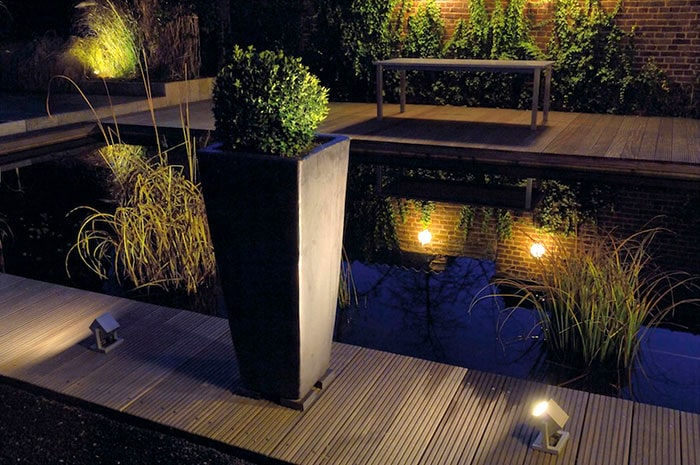
Inground lights
Inground lights make creating a dramatic effect in our external area easier. As the name suggests, these lights are in the ground. That means the light fixture is not visible – only the light it produces. This is great for illuminating pathways, driveways, staircases, and steps. It creates an uplighting effect that has mysterious shadows and beautiful silhouettes. When using this type of outdoor light, ensure you use LED lights so maintenance will be below. The installation should be done appropriately so it doesn’t pose upkeep problems in the future.
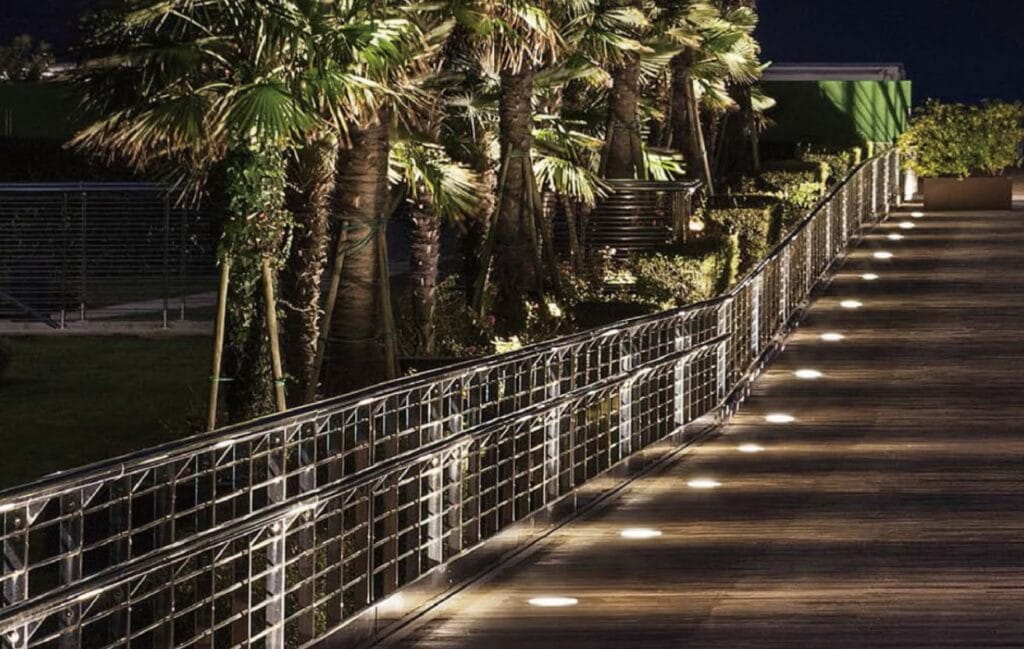
Wall lights
Outdoor wall lights can fit any flat surface. It’s not only for houses or garden walls. You can install these lights on a column beside the front door, a covered porch – even trees. Wall lights are versatile enough to use in any area outdoors. Depending on where you decide to install it, these can light up walkways, pathways, driveways, stairways, covered porches, decks, etc. Make sure you don’t use bright light fixtures. You don’t want any glare because that might compromise visibility in the area.
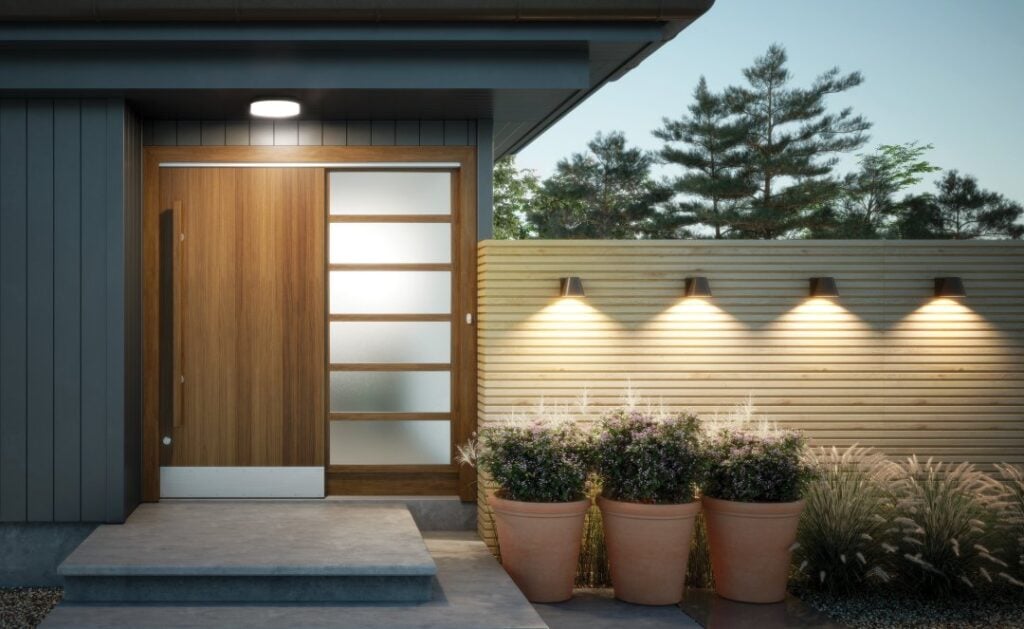
Hanging lights
These outdoor hanging lights illuminate entryways, garden structures like gazebos, and covered decks and patios. Think of it like outdoor chandeliers. Often, these lights are designed to be ornamental. Sometimes, these can be attached to outdoor ceiling fans too. It’s up to you how you want to include it in the overall design of the landscape.
Landscape lights
Landscape lights can be any exterior lighting. It could be LED bollard lights, landscape spotlights, wall, or in-ground lights. Anything that can enhance the facade of a structure – whether that’s a home, building, or garden structure. The primary function of these lights is to illuminate parts of the landscape. For instance, recessed lights can light up walkways to prevent accidents. Spotlights can feature trees and foliage around the garden so people won’t trip or run into anything.
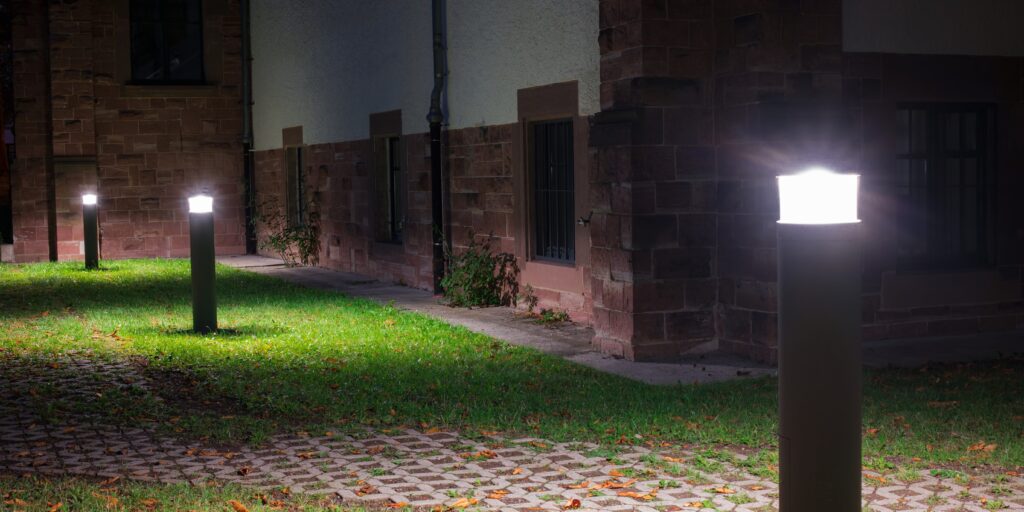
Post lights
This refers to both tall and short post lights. A post light is found on top of a tall pole. Usually, outdoor post lights illuminate an ample space without being too bright. That makes it an ideal part of your security lighting. Maybe put it near the driveway. Pathways can use bollard lights – technically, just shorter versions of post lights.
Path lights
As the name suggests, path lights illuminate areas where traffic happens. This includes both vehicles and people. So path lights could be bollard lights or in-ground lights. It runs down the path. While its primary purpose is to illuminate the path, there are times when it helps define lines or borders. Bollard lights, in particular, can define the boundary between the path and the landscape.
What to consider when choosing outdoor light fixtures
Since there are several types of outdoor lighting, you need to know how to make the right choice. You see, all these lights may be perfect for outdoor use. But each of them has specific functions. For instance, bollard lights may be better for pathways compared to spotlights. Or a ceiling light or ceiling fan with lights is better for lighting up a gazebo. Stairways are better off using step lights and not floodlights.
Besides, the outdoor house lights you choose should complement your external space.
Now that you know this, what are the different considerations when choosing outdoor light fixtures?
Go for energy-efficiency
While outdoor lights still use halogen bulbs or incandescent lights, the common practice is LED lights. Although LED light bulbs are more expensive, experts still prefer them. Why? Because it’s more durable, environmentally friendly, and doesn’t require replacement bulbs for a long time. Best of all, it’s energy-efficient. You can get bright lights even with very low wattage. That means using LED light will consume less energy. That’ll allow you to save on energy bills without compromising the bright light you need outdoors.
Pick the right wattage.
Let’s not forget about the main function of outdoor light bulbs. These seek to illuminate any area. If you’re lighting up a huge space, pick a light that can produce enough brightness. Of course, that brightness will depend on the wattage of the light bulbs. If you need it to be very bright, get outdoor lights with a high wattage. But a low-wattage bulb should suffice if you only want to produce ambient light.
You can consider this rule. If the light fixture is for functional purposes, choose lights with higher wattage. But if it’s only for decorative purposes, low wattage will do.
Then again, this is why it’s great to use LED lights. These come with controls that’ll allow you to adjust the brightness of the lights. You can even install motion sensors. That way, the motion sensor light will switch brightness depending on whether it senses someone moving that needs light.
Choose durable light fixtures.
All types of outdoor lights should be durable. For one, it should be weather-resistant. You want to ensure that the light bulb will survive the outdoor elements. It should withstand the heat from the Sun and strong rain showers.
If you get LED lights, you can trust that they’ll last much longer if you compare them to compact fluorescent bulbs or incandescent lights. LED lights also won’t heat up even if it remains open for long periods. You’ll get a long-lasting light fixture that won’t consume much energy to provide bright lights.
Decide on the color temperature.
The color temperature of the outdoor lights uses the K scale – or Kelvin range. Your options will range from warm to cold – with a scale of 1000K to 10000K. Typically, residential or commercial lights’ color temperature falls between 2000K to 6500K. The lower the Kelvin numbers are, which means the light is warmer. It’ll appear yellow. If the Kelvin numbers are higher, the color temperature is cooler. It’ll appear bluish or even brownish.
Ideally, warmer color temperatures of 2500K to 2700K should be for architectural elements. But if you want to light up trees and plants, choose lights with cooler temperatures of 3000K to 4000K.

Select how many lumens
Lumens refer to the brightness that the outdoor light bulb can emit. That means if you’re looking for security lights for a motion sensor, you must look for light fixtures with more lumens. If it’s just for ambient lighting, the lumens can be lower.
The ideal range for outdoor lights should be between 12 and 1300 lumens. If it’s just for lighting a landscape, 50 to 700 lumens should suffice. But if you need it to make pathways or steps visible, you might want higher lumens.
Make sure it has a waterproof rating.
If you plan to position the lights near a water feature outdoors, ensure it has the right waterproof rating. Usually, if the lights have a high chance of getting wet, the waterproof rating should be IP65 to IP67. This is a must for underwater spotlights, pool lights, fountain lights, etc. But if it’s just for outdoor areas that will be exposed to the rain, an IP44 rating should suffice.
Think about using solar energy.
If you want your outdoor lights to be energy-efficient, use solar-powered lights. That means it gets the energy from the Sun. That means the lights should have exposure to sufficient sunlight. Post lights, path lights, and bollard lights can be solar-powered. If your deck lighting or wall lanterns are not under direct light from the Sun, it’s useless to get solar-powered fixtures for them.
How to design your outdoor lights
Outdoor lights come in various shapes, sizes, and designs. Even manufacturing companies can customize the design to suit your lighting requirements.
But what should you consider when coming up with the design of your outdoor lights?
It should complement your home.
If your home has a modern feel, you might want to stick to a modern design for outdoor light fixtures. The same consideration should be made for the color of the main structure.
You can do this for the highly visible lights. For instance, the wall mounter exterior lights beside your front door. Or the bollard or post lights that are standing on your property. Any light fixture that you think people will see – tie the design to that of the main structure in the property.
If the light fixture includes inground or hidden step lights, there’s no need to consider the design too much. Just make sure it’s made of durable materials.
It’s important to choose the right outdoor lights for the front part of your home or building. Why? Because this will have a huge effect on the property’s curb appeal.
It should promote safety and security.
The design of the outdoor lights should also consider safety and security. For one, the electrical wiring should be safely done and hidden from view. This will help avoid accidental electrocution. Or they are even tripping from the wires.
Although you’re free to use any material you want, ensure it protects the lights. If you’re unsure about this, check the standard lighting regulations in your area. There should be guidelines that’ll help keep your external lights safe.
Dig deep enough for tall light fixtures like post lights to ensure stability. You don’t want it to fall off when a strong storm hits your place. The same is true for bollard lights – although to a lesser degree.
It should fit the landscape’s design.
Apart from the house or building structure, the lights you’ll use should fit the landscape’s design. While planning what types of outdoor lighting to use, walk around the property. Pinpoint where you want to put lights. This will give you an idea of the type of lights you’ll use and the design you’ll want it to have. You don’t want the lights to clash with the landscape design. It’ll stick out like a sore thumb – ruining the overall look of your landscape.

It should highlight important features of the landscape.
Do you have a water feature like a pond or fountain? Put some lights there. Choose between underwater lights, pool lights, or spotlights. Consider properly positioning the lights it can refract beautifully when it hits the water’s surface. The water’s movement will also make the light’s reflection move.
Choose spotlights or wall washers for the columns, structures, and walls you want to highlight. These will accentuate the features that you’re lighting up.
It should have the proper spacing.
One of the considerations when choosing the design of the outdoor lights is the spacing. Some designs will reflect brighter lights – making them ideal for bigger spaces. That way, you won’t have to buy a lot of light fixtures to get the illumination you prefer.
Ensure you understand the minimum spacing requirements of specific types of outdoor lighting. This includes post lights, bollard lights, path lights, etc.
It’s also important to consider the light output. Ensure enough for all the lights you’ll put in your landscape.
What are the different outdoor lighting techniques?
The lighting technique you want to do will also determine the types of outdoor lighting that you’ll use. The lighting techniques include silhouettes, shadowing, uplighting, downlighting, wall washing, etc. There’s a specific light fixture that can help you with these lighting techniques.
For instance, spotlights are great for creating silhouettes, shadowing, uplighting, and downlighting. You have to determine the positioning of the spotlights. Inground lights are also great for uplighting.
Floodlights are good for simple illumination needs that require a wider beam of light.
The design should also consider the lighting technique that you want to achieve. If you want to lower the glare of the lights, use frosted glass instead of clear ones. This is great for lights that you’re using for ambient lighting.
Other questions about outdoor lights
How do you uplight a tree?
The best way to do this is to use spotlights. Position the lights, so it angles upward to illuminate the top part of the tree. Put the spotlight far enough, so the beam light reaches the top.
Why are LED lights better for outdoor lighting?
LED lights are known for being durable, energy-efficient, and flexible. These lights can come with controls that allow you to adjust the brightness. These are also safer because the LED lights don’t heat up like how incandescent lights do.
How many lights should I buy for my landscape?
This would depend on a couple of factors. First is the size of the area you want to illuminate. Bigger spaces require more lights. You should also consider the brightness that you need. If it’s for security purposes, you want it to be brighter. That could affect the number of light fixtures you’ll get. But if it’s for mood lighting only, fewer lights may suffice.
Final thoughts…
It’s not unlikely that you’ll use different types of outdoor lighting for your landscape. Some areas will need a different type of light fixture. There are lights for security purposes, while others are for aesthetic appeal.
Either way, you’ll always win if you get outdoor LED lights. It will cost more than you buy the first time. But it’ll be worth it since you’ll be saving money. Not only does it consume less energy, but it also wouldn’t need replacing for a long time.
RC Lighting is here to help you get what you need if you have a specific outdoor lighting requirement. We customize outdoor lights. We also use only the best materials to design every LED light fixture.




